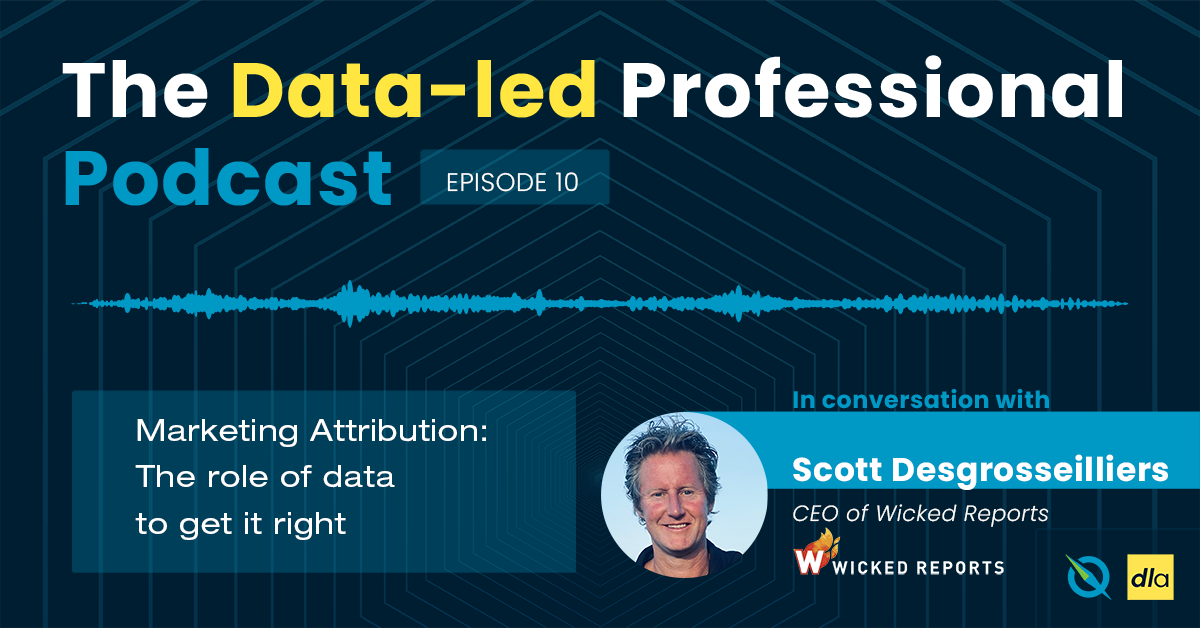Why marketing attribution is important, who should care about it, challenges and key elements
In this week’s episode, join special guest Scott Desgrosseilliers, CEO of Wicked Reports, and hosts Claudiu Murariu, CEO and Co-Founder of InnerTrends, and Arpit Choudhury, Founder of Data-led Academy, as they discuss marketing attribution: why it is important, who should care about it, what are other attribution challenges one should be aware of, key elements of attribution and so much more.
What is marketing attribution?
Marketing attribution, or marketing attribution modelling, is the analytical science that helps marketers to identify the ROI on their marketing investment, by getting insights into what touchpoint or combination of touchpoints influences the potential customer towards a goal completion or a specific conversion.
With a far from linear buying process and conflicting information from advertising platforms, marketing attribution is a must today, yet not all marketers are doing it, or are not doing it right. Let’s dive into the discussion and understand more about attribution.
Select excerpts from the episode:
Why is marketing attribution important?
[Scott] We’ll explain this with a story about lobsters and attribution! It really shows the impact of being able to track your results versus if you’re not.
A friend of mine was running an e-commerce store on WooCommerce selling Maine lobsters back in 2014. His initial growth was through Groupon, a coupon site, which was a huge deal at the time. And he grew to 2 million in revenue, just off daily deals. Since that started to peter out, the owner was looking for another channel and Facebook was quite new at the time. And he calls me up and he says, “You know, Scott, Facebook, it just sucks for lobster”. And I was like, “Why is that?” And he said, “Well, I spent $4,000, which was my entire budget. I got 12,000 clicks, but I only made one sale for $200. I’m never doing that again”.
Then we started thinking about time to buy – maybe these people take more time to buy – but there was no way to know this. The only thing available at the time was something called Visual IQ (today’s Nielsen), which started at 100 grand a month, so that was out of his budget.
And there was nothing reasonably accessible and simple for a small e-commerce store. So I hacked up this idea which was very elaborate. Every single link was going to have a different string on it and was going to tell us who we had targeted. And we’ll track and see if they ever end up buying. We had a simple opt-in page where people could get a 50% discount coupon.
We only counted a sale if it showed up in the WooCommerce platform – that’s similar to what you would call today first party data, which has come into vogue now. The ad spent was $5,000 and the income he made back was $4,000. So within one month, the e-store had lost 10% of the investment. Three months out though, those same leads yielded $50.000. And the owner was blown away.
And then slowly but surely the business grew; they spent over $4 million in seven years on advertising, and they’ve made $32 million in revenue. And all of that thanks to attribution, to knowing how, when and where people buy.
[C] There’s quite some ROI there. What’s amazing is that the only difference between the first time and the second time – since he spent pretty much the same amount on advertising – was the data that he had available.
Who should care about attribution?
[S] Attribution starts to become a pain point once a company spends about $10K a month on advertising, or if they’re using multiple channels, which most companies are.
Almost all companies are using some sort of email automation, they’re running ads on Facebook, and hopefully, doing also Google search, Google ads, etc. Because once you have multiple channels, none of those are going to report the truth.
There’s so much complexity within each ad platform, and they are not going to worry about crediting each other. Their job is just to say, “Let’s run ads, let’s get you some traffic”. And hopefully you convert it. So how and from where that traffic converts is a problem you need to solve as a marketer, and that’s what marketing attribution can do for you.
What are the three things marketers can do to solve this problem?
- Get the right data
- Get the right insights
- Act on the insights
Acting on the insights is the toughest part and the most critical factor. Wicked Reports has created playbooks for marketers explaining how to act.
Why is attribution hard?
For one, because there’s time involved. People are used to seeing data in the ad platforms and essentially have been looking at the wrong thing for years now, as ad platforms don’t approach attribution the correct way. So there is a lot of education to be done as well, and that’s our role and part of our process.
What does it take to act upon that data?
[S] You need a goal first of all! And then once you know the goal, then you can get the right insights to the right report. You do need a framework on how to act on it, and it has to be consistent. With a specific framework of how you’re going to act, the process is repeatable, like a scientific method. Only then you’re going to be able to effectively gauge the results.
If the ROI is this, you’re going to increase spending by x% and get these results. Essentially, you are able to increase your return on investment.
What are the things that people get wrong about attribution?
First, people do not look at real conversions. They’ll see what’s in Google Analytics, or they’ll see what’s in their Facebook conversion reporting (which is estimated, modeled and delayed), and what’s in the email marketing application. If you add them up, the numbers will be higher than what the e-commerce platform reports. So now you can at least understand the problem and start with something real.
Another point – and this is important especially for SaaS companies and any business with a recurring revenue stream (the higher the pricing point, the less likely your first ad is going to close someone) – there’s a consideration phase that happens the more that commitment is. So that means your cold traffic ads or your middle traffic ads are more important as they’ll help you understand what drove people to buy. But the scoring systems in Facebook and Google heavily weigh the final step. And that’s another aspect of attribution that people get wrong.
Another big thing is customer lifetime value. The bigger the customers are, or the more valuable, they might be harder to find or cost more to get. But they’ve got more lifetime value. So if you’re looking only at CAC, you’re using the wrong measure, or you’ve got the wrong constraint on your data.
So acting upon the data also means looking at the bigger picture, not just the acquisition moment. People don’t use CLV in attribution, they’re all worried about the immediate value. And that’s a mistake.
[C] Yeah, and to expand a bit on the customer lifetime value. To do attribution right, you need to make the attribution at customer level, not at cookie level, not at device level. You actually need to link the traffic sources to the customer so you can follow that across time. You can know in six months from now, this marketing channel that touched my customer, this is how much it contributed to my bottom line. Most of the data gets lost if you’re totally cookie-based or device-based, so that’s why people focus on the first conversion.
[S] Exactly. And that’s the big flaw with Google Analytics as it’s cookie based.
That’s why capturing an email is so important now, because then you own the data. You may miss some clicks, it’s not going to be as easy, but it’s a better, stronger signal. Particularly for cold traffic that becomes high lifetime value customers, which everybody wants. And that’s the Holy Grail. That’s when you can actually scale.
Why not just use Google Analytics for attribution?
Apart from the cookie-base issue, lifetime value is missing. If a super-skilled data-led professional is using a customer data platform like Segment, and Google Analytics, they might pull it off. But that’s hard to do.
If you’re just going into Google Analytics, where you don’t have lifetime value, and you don’t have that separation of cold versus warm traffic, versus closed people versus repeat customers, you don’t have the right context. You’re just looking at some numbers and trying to react and the data itself isn’t good enough to give you the insights you need.
How can you scale when you don’t know if a message really works on cold traffic, or on existing customers rebuying your stuff?
Then, there’s the time window, which is too small. If your sales process is longer than that, you may be cutting a great ad too early.
[C] Let’s comment on Google Ads attribution. It’s important to highlight that when Google Ads say attribution, they only mean attribution on their own clicks. So if you have multiple clicks on ads, they will do attribution on those. It’s not about attribution with other marketing channels. So whenever you see attribution, it means that you spent money on multiple Google Ads campaigns. It’s not about sharing those with other traffic sources. It’s good to be aware of this as it could be misleading.
Attribution has to be the source of truth and channel-agnostic.
Well, let’s dive into attribution models.
What are attribution models and how should they be used?
[S] That’s a good question, as attribution models can get confusing for marketers. What we found that works best is we ask people, “What is your intent with the marketing campaign?”, because the intention drives which attribution model you should use. The goal is – of course – to find high lifetime value customers.
- If you are targeting cold traffic, then you need to use a specific model for that: New Lead Attribution Model, which we cross reference with your CRM against the clicks, to make sure we really created a new lead. And then we wire into the billing system to see the revenue and we map them back. That’s a single-touch model, and we’re trying to see what finally made people give away their email – i.e. the strongest signal for lead gen –, and that’s a good thing to scale top of the funnel.
- We also have a First Click Model, which is also one-touch. That’s matching the intent of “I want to show my ads to brand new audiences, and see what attracts them over and if they eventually become a customer, days or weeks later”. In other words, what first interests cold traffic that becomes high value customers over time.
- There’s also a Multi-Touch Model that people often use as they like the idea of “it’s less to think about”. They want to understand what is working and what is not, especially when their targeting is broad.
To sum it up, what you are looking to do determines what model you pick.
At Wicked Reports we have a matrix where you select what your question is, and then it shows you which model to use. And based on that it shows you how to assess and scale whatever you’re looking at.
What are the top challenges of attribution?
- Which model to use is a big challenge – because a lot of times the ad platforms are showing last click, or they’re showing a multi-touch model. Multi-touch here is tricky; there are situations where there are 300 touch-points involved in a purchase of a $100 item. If you want to give equal credit, it’s 33 cents a touchpoint. For one, nothing’s ever going to look profitable. And two, there’s no way that’s true. A better option is to just value the higher signals more and not count view-based impressions at all. Unless we have nothing else. Let’s say there are no clicks anywhere, then we’re stuck taking view-based impressions into consideration.
- Another challenge is that some companies have really convoluted tech stacks and it’s difficult for them to set up tracking. If you can’t set up Google Tag Manager, it’s gonna be troublesome for you to set up any attribution platform because you need the tracking script everywhere.
- Not taking into account client lifetime value is another challenge. Not actually starting from sales or not considering repeat or recurring purchases is a big challenge that people don’t consider. And we’ve already talked about that a lot.
- Lack of patience would be another challenge. So you set it up, we run an analysis, we cross reference your CRM against your cart. We see how long this lead took until they purchased your product. And we run that average to see how long leads normally take to buy. And then we generate a histogram.
Having patience is important, as attribution is a strategic thing. It can take a couple of weeks to get some understanding, and then maybe a month or two until it’s totally tightly dialed in. People, in general, are impatient. They buy tools, and they want the easy button, “Hey, I bought it. I’m done”. And we don’t sell that, because it’s not true. Attribution works though and we can help prove ROI pretty well.
What is normally missing from most attribution solutions?
What’s normally missing is CRM integrations which are hugely important to understand differences between cold, warm and hot traffic. That’s a big differentiator, because we find where cold traffic really works and what scales.
The other thing is what we call missed opportunities reports that get triggered when you turn off campaigns that have later on proven lucrative. So you might want to go back and look again at those campaigns.
Cohort reporting is a big thing. Because to understand lifetime value, you need to look at and understand your cohorts.
Conclusions
- Many marketers admit that attribution is important, however not many people use it, because execution is not easy, especially in today’s world with cookies and device IDs, and so on, and it gets even more complex. While attribution is hard, it’s really good that new tools get into this space that help marketers with this challenge.
- You need to have patience, and it will eventually give you positive ROI.
- Take into consideration client lifetime value and do cohort-based analysis
[A]: What about the case of B2B SaaS? How should these companies look at attribution? Because typically, B2B SaaS may not have as many channels, a lot of companies may or may not do Facebook ads, they might be doing only Google ads, and they might be doing a lot of organic stuff such as content marketing or community marketing, which is becoming huge.
[C]: SaaS companies invest a lot of time and resources in doing all of those activities. And they actually care a lot more about attribution. Because every click is so expensive. However, B2B SaaS companies have a great advantage: the free trial, the lead. And then you have pretty much everything that Scott talked about on how to attribute to people, to lifetime value, to cohorts. That happens by default in SaaS B2B, so they have an easier life when it comes to attribution compared to B2C e-commerce.
Also SaaS B2B, especially the sales-driven companies, have very long sales cycles and a lot of touchpoints between different people in the organizations that they’re selling to. So it’s hard, it’s complex, but it’s easier than in e-commerce, especially with the tools that are on the market, Wicked Reports being one of them.
Tools mentioned in this episode
E-commerce Platforms
Customer Experience Automation (including email marketing, marketing automation, CRM)
- Klavio
- Infusionsoft (now Keap)
- Active Campaign
- Ontraport
Marketing Attribution
- Nielsen (acquired Visual IQ)
- Wicked Reports
About Wicked Reports
Wicked Reports combines innovative attribution models with 1st party CRM and sales data to automatically detect your most important conversions and show you the true ROI of your ad spend. Understand what works at each stage of your marketing funnel and scale campaigns that are ROI positive over time. More information on wickedreports.com
Have any additional questions about why companies fail to use their data and how to change that, or any other topics you would like to hear covered on The Data-Led Professional Podcast? Comment below! We can’t wait to hear from you.
Subscribe for more episodes on your favorite streaming platform or subscribe for InnerTrends updates here.
Listen on Apple Podcasts Listen on Spotify Listen on Google Podcasts Listen on Stitcher




